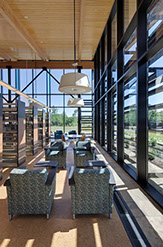February 17, 2015
Daylighting in the Library

Laman Library Argenta Branch
“Light and airy” is a desire we often hear from our clients, whatever type of building project they have undertaken. This has become a familiar slogan with libraries as well. They understand intuitively that spaces are more comfortable, usable, and pleasant if there is ample natural light. We learned this from wonderful historic buildings with large, beautiful windows, but seemed to forget it in the ‘60’s with the widespread use of air conditioning. Windows were largely ignored in those ‘60’s designs in an effort to build buildings that worked like refrigerators; they became low ceilinged, fluorescent lighted, mean spirited places that made humans cranky.
So, we agree that windows are good. How do we use them – walls of glass, skylights, multiple windows, monitors or what? The answer is that great care must be taken in how we incorporate natural light. It is critical in library design to maintain consistent lighting levels for visual tasks. We must consider and analyze the orientation and size of window openings; the type of glazing (glass) for different exposures; the use of exterior sunscreens, interior window coverings, and skylights and monitors.
Visually, for the most comfort, light should be balanced. Take, for example, places you’ve been that have one window at the end of a long room. Near the window, it is very bright, but it becomes darker rapidly as one moves to the back of the room. This “tunnel effect” is most unpleasant and creates little more than glare in a dark volume.
We subscribe to the rule that all rooms should have windows on at least two sides to balance the light. Christopher Alexander, in his book, A Pattern Language, states, “People will always gravitate to those rooms which have light on two sides…”. The most wonderful rooms have natural light on 3 sides, and even better if monitors or skylights can be incorporated in the interior space of the room – all to balance the light.
Considering energy efficiency and sustainable design, the cost of lighting any building is one of the largest uses of energy. Daylight is a free and renewable source of light. It can visually and physically warm an interior space on a cold winter day, and provide views to the outside all year round – proven to elevate occupants’ moods. Daylight is efficient; it produces twice the lumens per watt of a fluorescent lamp, ten times that of a incandescent source, and is even more efficient that LEDs. Strategies for incorporating – and featuring – daylighting can reduce demand for lighting, which in turn, can minimize loads for cooling equipment. 
So the next time you visit your local library, nestle down in one of those big, comfortable lounge chairs by the windows in the reading room; soak up the sunlight while reading or working, and enjoy!
Oley E. Rooker Library,
Central Arkansas Library System

John Allison, AIA, LEED AP
ja@allarch.com
John has almost 40 years of professional experience as a licensed architect. He formed Allison Architects, Inc. in 1995 to concentrate on providing responsive and personalized architectural, planning, and interior design services. In his free time, John likes to cycle and uses his design skills in another visual medium - painting.
Next Post
Return to Blog Home Page
Previous Post